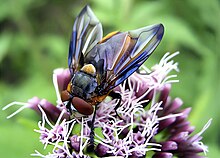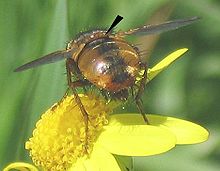Caterpillar flies
| Caterpillar flies | ||||||||||||
|---|---|---|---|---|---|---|---|---|---|---|---|---|

Caterpillar fly |
||||||||||||
| Systematics | ||||||||||||
|
||||||||||||
| Scientific name | ||||||||||||
| Tachinidae | ||||||||||||
| Robineau-Desvoidy , 1830 | ||||||||||||
| Subfamilies | ||||||||||||

The caterpillar flies (Tachinidae), also parasitic flies , are a species-rich family of two-winged flies with around 8000 species worldwide, of which around 500 species are represented in Central Europe.
Systematics
The caterpillar flies are seen as a sister group of the Rhinophoridae , together with them as a sister group of the botfly . They belong to the Calyptratae , the further relationship of the house flies and blowflies .
The system within the caterpillar flies is still largely unclear and controversial. There are usually four subfamilies:
- Phasiinae : This group is represented in Central Europe with around 60 species. In terms of body structure, they are quite different, some species are slender with an elongated abdomen, others have a spherical or flattened, brightly colored abdomen. In contrast, they are relatively uniform in their biology, bugs are predominantly parasitized and the eggs are still immature when they are laid. The strikingly colored bedbug fly belongs to this group .
- Dexiinae : In Central Europe there are around 75 species of this subfamily that parasitize on beetles, butterflies and sawfly. The larvae of this group are ready to hatch when they lay their eggs.
- Tachininae : A large and relatively heterogeneous group with a wide range of host species. This group includes the hedgehog flies , which are particularly large and common species. The eggs of all species already contain larvae that are ready to hatch.
- Exoristinae : The subfamily with the most species includes numerous quite different groups. There are some groups that lay immature eggs, but most of the larvae hatch shortly after they have laid eggs.
anatomy
The caterpillar flies resemble the house flies and blowflies at least superficially. A definite distinguishing feature from these and other closely related groups is the post-cutellum, which protrudes like a bulge under the scutellum, which forms the posterior edge of the upper side of the thorax. In the other groups, the posterior side of the thorax under the label is more or less flat.
Way of life
All species develop parasitically in larvae, pupae or imagines of insects, occasionally also in other arthropods. Among the host animals are primarily caterpillars of butterflies and anal caterpillars of plant wasps . Beetles , however, are also parasitized, namely in addition to the larvae of mainly scarab beetles and longhorn beetles , pupae and the imagines of larger species such as ground beetles or cockchafer . Other host species can be found under the bugs , grasshoppers , cockroaches and earwigs , occasionally also hymenoptera and two-winged birds . Water-dwelling species and insects that are out of the question because they are too small are excluded.
Most caterpillar flies specialize in a few host species or a single species, but some have a very broad host range. Some species are limited to host species that live on a specific forage plant.
The eggs of the caterpillar flies are either deposited directly on the surface of the host or in its vicinity; the females do not have a laying stinger to pierce the host animal. The larvae hatch after a short time, sometimes immediately after they have laid their eggs.
The adult flies are mostly diurnal and feed mainly on flower nectar and honeydew. They are often found on flowers with easily accessible sources of nectar; only a few species have a proboscis that is sufficient to reach the nectar of flowers with a long tube.
Fossil evidence
Fossil caterpillar flies are rare. The oldest evidence comes from Eocene Baltic amber . Finds from the somewhat younger Dominican amber and from various Quaternary deposits are also known.
Economical meaning
In agriculture, caterpillar flies are of great importance for biological pest control. Insects in particular, which caused considerable damage through mass reproduction after being spread to other continents, could be brought under permanent control through the subsequent introduction of the respective parasitic caterpillar fly. Examples of this are the little frost spinner and the gypsy moth .
Types (selection)
- Buquetia musca
- Cylindromyia brassicaria
- Ectophasia crassipennis - broad-winged caterpillar fly
- Gonia capitata
- Kirbya moerens
- Mintho rufiventris
- Nowickia ferox
- Phasia aurigera - Gold Shield Fly
- Phasia hemiptera
- Phasia pusilla
- Tachina fera - hedgehog fly
- Tachina magnicornis
Individual evidence
- ↑ George O. Poinar, Jr .: Life in Amber . 350 pp., 147 figs., 10 plates, Stanford University Press, Stanford (Cal.) 1992. ISBN 0-8047-2001-0
- ↑ http://hbs.bishopmuseum.org/fossilcat/fosstachin.html fossil Diptera
literature
- Hellmuth Gäbler: The caterpillar flies . 2nd, unchanged edition (reprint of the 1st edition, Akademische Verlags-Gesellschaft Geest & Portig, Leipzig 1952). The new Brehm library, issue 53. Westarp-Wissenschafts-Verlags-Gesellschaft, Hohenwarsleben 2003, 29 pages, ISBN 3-89432-540-2
- Benno Herting: Biology of the West Palearctic caterpillar flies Diptera, Tachinidae . Monographs on applied entomology, No. 16. Parey, Hamburg and Berlin 1960, 188 pp.
- Joachim Ziegler: The morphology of the puparia and of the cephalo-pharyngeal skeleton of mature larvae of tachinid flies (Diptera, Tachinidae) and their phylogenetic evaluation significance] . Dissertation. Studia dipterologica, Supplement 3. Ampyx-Verlag, Halle (Saale) 1998, 244 pages, ISBN 3-932795-02-4

